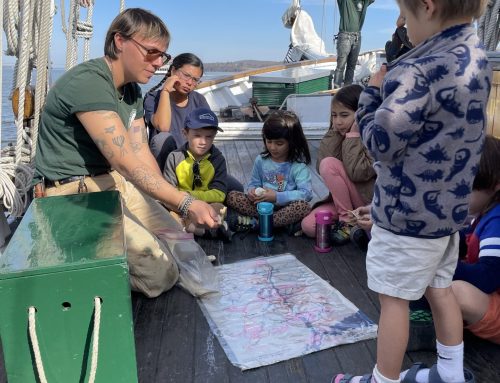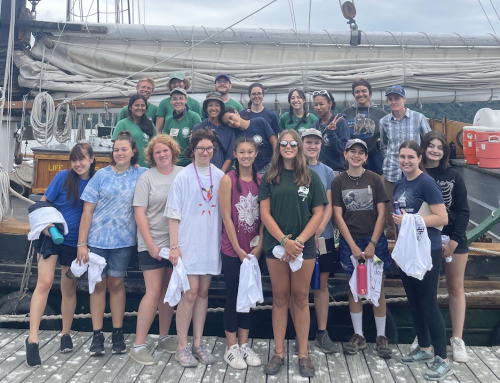By Tom O’Dowd, Onboard Education Specialist and “sylvan educator”
Editor’s Note: Through the winter months, Clearwater educators – eager to teach, and learn! – will post an Educator Blog covering the Hudson River from Lake Tear of the Clouds to the Battery in NYC . Dividing the river into 15 to 20-mile-long stretches, we will cover the entire river by the time we’re sailing again in April. Our tri-fold focus will cover Cultural History, Natural History, and Environmental Issues, and will include factoids and ponderables to stimulate the minds of even the most seasoned river lovers!
Image: Viewing platform atop McCauley Mountain. Photo credit: Wikipedia
Natural History: In about 1866, artist and naturalist (and Poughkeepsie resident) Benson J. Lossing and crew (sometimes just his wife) travelled by horse-drawn carriage and then by foot up the Hudson River and back down again, looking for the heart and soul of the Adirondacks. His descriptions (and woodblock prints) give us a picture of the headwaters of the Hudson River–when the population of New York City was only 300,000! Lossing wrote:
“These mountain and lake districts, which form the wilderness of norther New York, give to the tourist most exquisite sensations, and the physical system appears to take in health at every pore. Invalids go in with hardly strength enough to reach some quiet log-house in a clearing, and come out with strong quick pulse and elastic muscles…No wild country in the world can offer more solid attractions to those who desire to spend a few weeks of leisure away from the haunts of men. Pure air and water, and game in abundance, may there be found, while in all that region not a venomous reptile or poisonous plant may be seen [he apparently missed the timber rattlesnakes around Lake George], and the beasts of prey are too few and shy to cause the least alarm to the most timid. The climate is delightful, and there are fertile valleys among those rugged hills that will yet smile beauty under the cultivator’s hand. It has been called by the uninformed the ‘Siberia of New York;’ it may more properly be called the ‘Switzerland of the United States.'” Benson J. Lossing. The Hudson: From the Wilderness to the Sea. 1866. p.44 (Foreword by Pete Seeger!).
Cultural History: The Adirondacks have lots of trees. How humans have used these trees has evolved over time. In Lumberjacks and Rivermen in the Central Adirondacks 1850-1950 Harold K. Hochschild talks about the evolution of the conservation ethic here:
“When white men first entered the American wilderness, Europe, and before it, Asia, they learned from bitter experience the cost to their civilizations of ravaged forests. The Native American pioneer thought of the woods, and of what grew and lived in them, only in terms of his own survival, but their were far-sighted conservationists…”
…such as the Earl of Bellmont, colonial governor of New York from 1698 to 1701, who “tried to limit the cutting of big pines for masts for sailing ships.” (Eastern white pines once reached heights of 200 feet and diameters of 6 feet!). “In trying to effect a compromise between silviculture and the sawmill, Lord Bellomont was moving, far ahead of his time, toward what is now called selective logging” (p. 7). (Incidentally, this Governor probably played a big role in the story of Captain Kidd –hiring him as a “privateer” until he was deemed a pirate. Then he had him caught and sent to England, where he was hanged! He also doled out first peoples’ lands with abandon. Not a crunchy environmentalist!).
Alas, any colonial spirit of conservation went out the door with the Revolution for Independence and eventually the Industrial Revolution. Early American loggers left young trees standing because there were so many large (probably old-growth) trees to cut but later experienced sparser forests and greater demand: “The Adirondack forests supplied the demands of New York’s industry during a period of enormous expansion. Between 1840 and 1890 the state’s sawmills consumed the growth of centuries” (Hochchild p. 7).
A plan for conserving Adirondack forests materialized just before they were totally annihilated. What is now Article XIV of the New York State constitution was spurred on by Verplanck Colvin (the surveyor famous for coining the name “Lake Tear of the Clouds”) and states that
The lands of the state, now owned or hereafter acquired, constituting the forest preserve as now fixed by law, shall be forever kept as wild forest lands. They shall not be leased, sold or exchanged, or be taken by any corporation, public or private, nor shall the timber thereon be sold, removed or destroyed.
“It was conceived in time to save New York’s private timber resources from complete exhaustion by the demands for lumber, wood pulp and – still by far the largest of the uses of timber – firewood” (Hochchild p. 8).
Environmental Issues: The Adirondacks have been the sources of other natural resources besides trees. Iron and garnet mines were very important in this area. In fact, garnet – the material found on most sandpapers and skateboards – was so important in New York state history that it became our state gem. Another state emblem is the Brook Trout, our state fish. Brook Trout were once common throughout the Hudson River watershed, but have experienced severe habitat destruction and competition with non-native species. The forest clear-cutting discussed above hurt the Brown Trout by day-lighting and thus warming their home waters. Dams cut off their migration routes and fild rivers with silt. Raised temperatures, increased siltation, and pollution all reduced dissolved oxygen levels (and trout need a lot of oxygen). Introduction of smallmouth bass, perch, and other trout species cut off their food supply.

Brook Trout (Salvelinus fontinalis): the state fish of New York! Credit: NYSDEC
These days, the DEC is working to restore Adirondacks lakes and streams to their native glory. You can help: never move fish! That would be considered “stocking”, and that’s the DEC’s job! Also, using live baitfish risks populating a waterbody with escaped baitfish. Don’t use live bait! Other things to consider: getting a fishing license helps pay for conservation work, and you might consider checking out conservation groups like Trout Unlimited (although they might not take a strong enough stance on hydrofracking for my tastes…).
Final thoughts: What’s fascinating is how dependent fish are on trees. I just “attended” a fantastic Hudson River Foundation webinar called “Are Hudson River Fish Made of Trees?” (find the PowerPoint presentation here). The answer is “yes!” Trees become part of the Hudson River food chain as they lose leaves, drop branches, or die, because bacteria break these plant parts into tasty morsels for fish or their prey. Dead plants flowing in from the Hudson River watershed actually provide more carbon for the system than green plants in the river itself! Protect the watershed = protect the river! This is why some of Clearwater’s green infrastructure
Incidentally, logging has returned to the Adirondacks – not for purely economic purposes, but rather as a conservation method! Read this nytimes article for more info!







